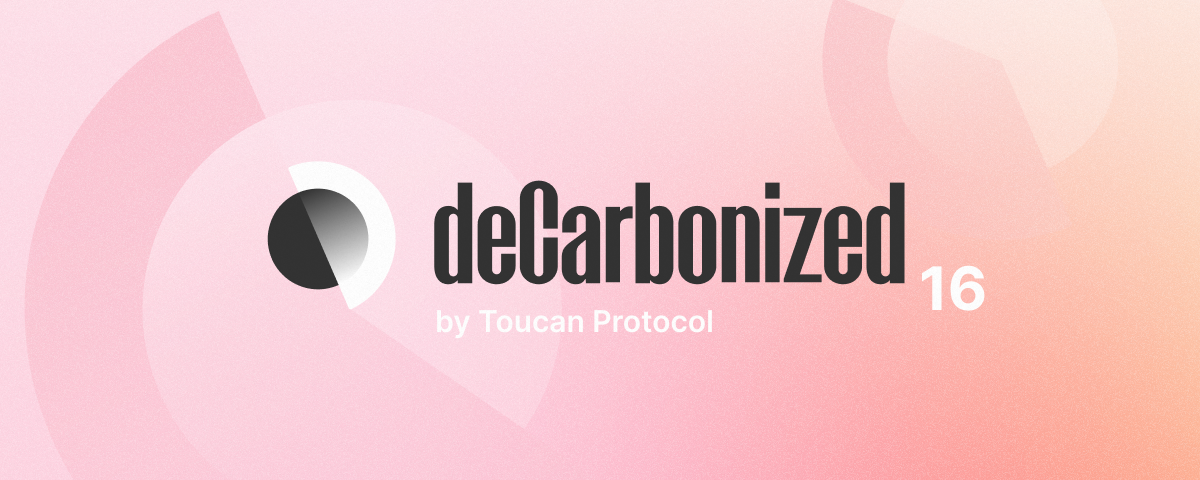deCarbonized #16: Web3 for carbon market transparency; growing urgency for nature markets
Verra advances plans for carbon units that leverage project finance upfront; Low carbon blockchain Algorand scores partnership with the FIFA World Cup; Voluntary carbon market price surge puts the profits of intermediaries in the crosshairs

⛓ On-chain weekly carbon stats
Toucan Protocol is building carbon market infrastructure to finance the world's best climate solutions. These are our on-chain stats from 28.04- 04.05:

Stats explained...
- Bridged: Toucan’s Carbon Bridge allows anyone to bring carbon credits from legacy registries onto the Toucan Registry
- Traded: This figure represents the combined $ value of all trades in the Base Carbon Tonne (BCT) pool
- Redeemed: Anyone can redeem carbon credits from the BCT or Nature Carbon Tonne (NCT) pool and pay a fee to specify the specific carbon tonne that they would like
- Retired: Redeemed BCT and NCT tokens can be retired and claimed as a carbon offset
🦜 Want to learn more about Toucan? Join us at our open office hours, taking place every Tuesday 12pm EST/ 6pm CET on Discord

📢 Top news
- Verra advances plans for carbon units that leverage project finance upfront
- Low carbon blockchain Algorand scores partnership with the FIFA World Cup
- Carbon credit platform Pachama raises $55 million in latest funding round
- Goodcarbon secure €5 million in pre-seed funding to accelerate investment in natural climate solutions

🌟Web3 for tackling VCM pain points
Lack of market transparency
Over the next few weeks, we will continue to dive into key VCM pain points (as recognized in the Task Force for Scaling Voluntary Carbon Market's final report) and explore how web3 can help to directly address these.
Having introduced the key issues and opportunities in part 1, part 2 explored the lack of upfront supply side financing. This week we delve into issues of market transparency 🕵️♀️
📍 The pain point
The current VCM can be characterized as complex, fragmented, opaque and lacking in consistent regulation. This greatly reduces transparency between project developers and credit purchasers, leading to high levels of market risk and inefficiency. This leads to:
- Standards fragmentation and double counting
- Low price transparency and high mark-ups
- Risk of non-delivery
Standards fragmentation and double counting
Multiple carbon registries exist that certify and index carbon credits, such as Verra and the Gold Standard. Each registry however, has a different approach to assessing and characterising the type of carbon credit a project produces.
BeZero for example, recently found 94 different credit types across the five major registries, alongside multiple other standards relating to credit co-benefits. This lack of consistency exacerbates the differences between credits, making it difficult to pool similar types into standardised units, assess value and set a consistent price point.
The current VCM therefore lacks the liquidity necessary to establish market efficiency at scale. Presently, credit buyers must be individually matched to appropriate projects, which is time consuming, inefficient and involves intermediaries like brokers.
The presence of multiple registries can also contribute to the double counting of credits, as visibility is lacking across the lifecycle of a credit. For the integrity of the voluntary market, making sure that double counting cannot happen is pivotal. Clear, unified and interoperable records are therefore key.

Low price transparency and high mark-ups
Once a project developer has had their credits certified and issued on a registry, they often sell these 'over the counter' to wholesalers or brokers, due to the issues of liquidity identified above.
These transactions involve a bilateral contract between two specific partners, which is not visible to the wider market in terms of price or numbers negotiated. The wholesaler or broker is then responsible for selling the credits on to an end user.
The involvement of these middle-men means that the final purchase fee by an end user often represents a sizeable mark-up, with “shockingly little data” available on how money paid for final carbon offsets is actually spent. Indeed, these transactions have been criticised by the US Securities and Exchange Commission for their lack of transparency.
Recent research identified some 250 projects where brokers resold credits for at least three times the purchase price. EcoAct are discussed as placing a high mark-up on one particular project, purchasing credits for $2.75 a tonne and reselling them for around $15.
The project developer involved however, discussed that this mark-up merely reflected the way in which the market had changed since EcoAct initially purchased the credits. Indeed, many projects require early engagement by brokers to attract a reseller to make the project attractive, meaning that changes in price during implementation reflect the actions of the free market.
Conversely, others feel that intermediaries are benefitting from trading in conditions that eliminate price transparency around the amount of money reaching developers and on the ground beneficiaries, with no regulation currently controlling this. This can make carbon markets appear extractive and lacking in integrity, highlighting the need for greater efficiency and transparency.
Risk of non-delivery
Lack of market transparency poses many risks to credit purchasers, including those of non-delivery or trades not being executed immediately, if at all.
There is exacerbated by a lack of market reference data, which can lead to a disconnect between the end user and what a project is delivering on the ground. This creates limited visibility into a project’s lifecycle or ultimate impact, or whether it meets expected standards around effective carbon offset delivery, including aspects of additionality, permanence and risk of reversal.
✨ How web3 can help
Web3 has the potential to tackle these issues by cutting out inefficient systems and intermediaries, leveraging blockchain to:
- Create market liquidity for greater price visibility
- Coordinate a single registry
- Improve transparency between market actors
- Reliably record and attribute data to different credits
Achieving this can primarily be tackled via the tokenization of carbon credits...
🔗 Tokenizing carbon
Tokenizing a carbon credit refers to turning it into a digital asset that lives on the blockchain. Each credit is publicly coupled with accompanying data on its origin and characteristics.
This is super useful, as it enables:
- The ability to pool similar credits, making different projects more interchangeable
- The creation of a market without intermediaries, as projects can sell credits to end users directly without the need for wholesalers or brokers
- Greater data retention and transparency, with project impacts more visible and tracible over their lifetime
🔍 Liquidity to reduce fragmentation and increase transparency
Toucan Protocol has developed a carbon bridge that allows off-chain carbon credit holders to bring their credits onto the Polygon blockchain network. On-chain credits can be bought and sold like other assets or deposited into carbon pools.
These carbon pools are collections of tokenized carbon credits with similar attributes. A Base Carbon Tonne (BCT) consists of Verra credits issued in 2008 or later and currently trades at around $3 a credit. A Nature Carbon Tonne (NCT) represents a credit issued after 2012 for a nature-based project and currently trades at around $7 a credit.
There are two key advantages that pooling credits creates:
- Greater transparency: Many types of credits are able to move in and out of the pools, creating a huge choice for end users seeking to offset. Where else can you find 167 different projects that you can immediately buy on the market?
- Price signalling: These pools have now amassed $30-40 million in liquidity, creating a very fluid and deep market where buyers can acquire large amounts of credits without significant price spreads or slippage.
To date, Toucan has tokenized over 21 million tonnes of carbon via its on-chain bridge from 167 unique projects.
Similar projects include MOSS, which has tokenized 2 million carbon credits on the Ethereum blockchain, and Nori and Regen Network, both of which work with farmers to produce, verify and tokenize carbon credits within their own on-chain registries.
🤝🏼 Registry coordination to avoid double counting
Web3 can enable the creation of a single meta-registry, bringing together all tokenized credits in one place to reduce issues of fragmentation and double counting.
On-chain registries additionally provide verifiable proof when a tokenized credit is retired as an offset by the end user, thereby solving the double-counting problem and fraud that plagues off-chain offsets.
The World Bank’s Carbon Warehouse project seeks to integrate compliance, voluntary and centralised UN carbon registries into one platform. This would allow for high levels of visibility across markets, enabling greater coordination. Toucan are seeking to support such efforts, building a neutral open meta-registry of BCT and NCT carbon credits.
🧮 Publicly available, immutable records to reduce delivery risk
Tokenized credits include all data relating to the history of the credit, including that captured directly using local devices for ongoing monitoring.
This data can be updated and move with the credit across different transitions and market places. Purchasers and watchdogs are therefore much better able to track offset claims back to the project source and have an understanding of impacts on the ground.
Next week we will explore the pain point of lack of quality assurance and sustainability 🔎

💼 Jobs board
- General Manager -Carbon, Sanergy - Nairobi, Kenya
- Product Manager, Toucan Protocol - Global remote
- Carbon Policy Analyst - Strategic Transformation, Worley - Las Vegas, US
- VP of Global Carbon Markets, Climate Finance Partners – Global remote
- Director, Net Zero (Carbon Markets), Winrock International - Arlington, US
- Head of Carbon Markets and ETS, Scottish Government – Glasgow, Scotland
🔎 Research in focus
Urgency for effective nature and biodiversity markets

A recent report by the Taskforce on Nature Markets explores what is needed to scale nature markets, with the aim of better aligning the global finance system with nature conservation and restoration.
The sustainability of our economic systems depends entirely on the health of our ecosystems. Essentially, nature is at the centre of the economy- every dollar, job and community ultimately depend on nature. This contribution, however, has historically been misvalued and undermined.
Nature markets seek to reverse this trend by generating nature-specific revenue streams. These would involve the trading of nature as the core product itself, such as food or wood products, as well as associated eco-system services, like pollination or water purification.
The mainstreaming of this need to value nature has been driven by four factors, catalysing a surge of activities and interest:
- Risk to economic prosperity
Concern regarding the potential impact of nature’s decline on our economic prosperity, set out in numerous publications, such as Dasgupta’s ‘The Economics of Biodiversity’. - Addressing climate goals
Nature plays a critical role in addressing climate goals, notably in its capacity for capturing and storing carbon. The report demonstrates for example, that forest elephants in the Congo Basin enhance forest carbon sequestration by 14%. If this population is protected over the next 300 years their economic value is estimated to be some $37 billion. - Business risks and opportunities
There is increasing appreciation by the business community of the risks and opportunities associated with nature, as reflected by the formation of the Taskforce on Nature-related Financial Disclosures. - Public engagement
Increasing media coverage has amplified concerns in relation to species and landscape loss, deforestation, plastics pollution and the links between nature and the current COVID-19 pandemic.
The Task Force on Nature Markets seeks to support the following in order to develop purposeful nature markets that deliver positive, equitable outcomes:
- Support successful existing and emerging approaches
- Build awareness of opportunities and risks for nature protection across policy, business and civil society
- Build a community of practitioners with a shared vision and narrative
- Encourage synergies between innovative people and platforms
- Recommend and advance standards of practices and enabling supportive governance arrangements
Read more about how web3 can support nature markets 🌳

Thank you for reading deCarbonized! 👏
Reach out to us on social and join the community ✨
Suggestions on what to cover next? Let me know @DrHolWat
Toucan is building the technology to bring the world's supply of carbon credits onto energy-efficient blockchains and turn them into tokens that anyone can use. This paves the way for a more efficient and scalable global carbon market.

